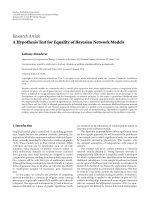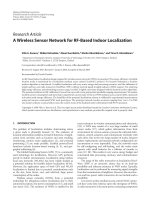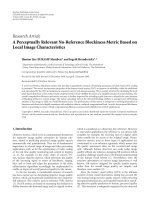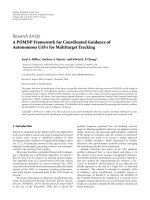Báo cáo hóa học: "Research Article A Multidimensional Functional Equation Having Quadratic Forms as Solutions" pptx
Bạn đang xem bản rút gọn của tài liệu. Xem và tải ngay bản đầy đủ của tài liệu tại đây (479.03 KB, 8 trang )
Hindawi Publishing Corporation
Journal of Inequalities and Applications
Volume 2007, Article ID 24716, 8 pages
doi:10.1155/2007/24716
Research Article
A Multidimensional Functional Equation Having
Quadratic Forms as Solutions
Won-Gil Park and Jae-Hyeong Bae
Received 7 July 2007; Accepted 3 September 2007
Recommended by Vijay Gupta
We obtain the general solution and the stability of the m-variable quadratic functional
equation f (x
1
+ y
1
, ,x
m
+ y
m
)+ f (x
1
− y
1
, ,x
m
− y
m
) = 2 f (x
1
, ,x
m
)+2f (y
1
, ,
y
m
). The quadratic form f (x
1
, ,x
m
) =
1≤i≤ j≤m
a
ij
x
i
x
j
is a solution of the given func-
tional equation.
Copyright © 2007 W G. Park and J H. Bae. This is an open access article distributed un-
der the Creative Commons Attribution License, which permits unrestricted use, dist ribu-
tion, and reproduction in any medium, provided the original work is properly cited.
1. Introduction
In this paper, let X and Y be real vector spaces. A mapping f is called a quadratic form if
there exist a
ij
∈ R (1 ≤ i ≤ j ≤ m)suchthat
f
x
1
, ,x
m
=
1≤i≤ j≤m
a
ij
x
i
x
j
(1.1)
for all x
1
, ,x
m
∈ X.
For a mapping f : X
m
→Y, consider the m-variable quadratic functional equation
f
x
1
+ y
1
, ,x
m
+ y
m
+ f
x
1
− y
1
, ,x
m
− y
m
=
2 f
x
1
, ,x
m
+2f
y
1
, , y
m
.
(1.2)
When X
= Y =
R
,thequadraticform f : R
m
→R given by
f
x
1
, ,x
m
=
1≤i≤ j≤m
a
ij
x
i
x
j
(1.3)
is a solution of (1.2).
2 Journal of Inequalities and Applications
For a mapping g : X
→Y, consider the quadratic functional equation
g(x + y)+g(x
− y) = 2g(x)+2g(y). (1.4)
In 1989, Acz
´
el [1] proposed the solution of (1.4). Later, many different quadratic func-
tional equations were solved by numerous authors [2–6].
In this paper, we investigate the relation between (1.2)and(1.4). And we find out the
general solution and the generalized Hyers-Ulam stability of (1.2).
2. Results
The m-variable quadratic functional equation (1.2) induces the quadratic functional
equation (1.4)asfollows.
Theorem 2.1. Let f : X
m
→Y be a mapping satisfying (1.2)andletg : X→Y be the mapping
given by
g(x):
= f (x, ,x) (2.1)
for all x
∈ X, then g satisfies (1.4).
Proof. By (1.2)and(2.1),
g(x + y)+g(x
− y) = f (x + y, ,x + y)+ f (x − y, ,x − y)
= 2 f (x, ,x)+2f (y, , y) = 2g(x)+2g(y)
(2.2)
for all x, y
∈ X.
The quadratic functional equation (1.4) induces the m-variable quadratic functional
equation (1.2) with a n additional condition.
Theorem 2.2. Let a
ij
∈ R (1 ≤ i ≤ j ≤ m) and g : X→Y be a mapping satisfying (1.4). If
f : X
m
→Y is the mapping given by
f
x
1
, ,x
m
:=
m
i=1
a
ii
g
x
i
+
1
4
1≤i<j≤m
a
ij
g
x
i
+ x
j
−
g
x
i
− x
j
(2.3)
for all x
1
, ,x
m
∈ X, then f satisfies (1.2). Furthermore, (2.1)holdsif
1≤i≤ j≤m
a
ij
= 1. (2.4)
W G. Park and J H. Bae 3
Proof. By (1.4)and(2.3),
f
x
1
+ y
1
, ,x
m
+ y
m
+ f
x
1
− y
1
, ,x
m
− y
m
=
m
i=1
a
ii
g
x
i
+ y
i
+ g
x
i
− y
i
+
1
4
1≤i<j≤m
a
ij
g
x
i
+ y
i
+ x
j
+ y
j
−
g
x
i
+ y
i
− x
j
− y
j
+
1
4
1≤i<j≤m
a
ij
g
x
i
− y
i
+ x
j
− y
j
−
g
x
i
− y
i
− x
j
+ y
j
=
2
m
i=1
a
ii
g
x
i
+ g
y
i
+
1
4
1≤i<j≤m
a
ij
g
x
i
+ y
i
+ x
j
+ y
j
+ g
x
i
− y
i
+ x
j
− y
j
−
1
4
1≤i<j≤m
a
ij
g
x
i
+ y
i
− x
j
− y
j
+ g
x
i
− y
i
− x
j
+ y
j
=
2
m
i=1
a
ii
g
x
i
+ g
y
i
+
1
2
1≤i<j≤m
a
ij
g
x
i
+ x
j
+ g
y
i
+ y
j
−
g
x
i
− x
j
−
g
y
i
− y
j
=
2 f
x
1
, ,x
m
+2f
y
1
, , y
m
(2.5)
for all x
1
, ,x
m
, y
1
, , y
m
∈ X.
Letting x
= y = 0andy = x in (1.4), respectively,
g(0)
= 0, g(2x) = 4g(x) (2.6)
for all x
∈ X.By(2.3) and the above two equalities,
f (x, ,x)
=
m
i=1
a
ii
g(x)+
1
4
1≤i<j≤m
a
ij
g(2x) − g(0)
=
1≤i≤ j≤m
a
ij
g(x) = g(x)
(2.7)
for all x
∈ X.
Example 2.3. The function g : R→R given by g(x) = x
2
satisfies (1.4). By Theorem 2.2 ,
the quadratic form f :
R
m
→R given by
f
x
1
, ,x
m
=
1≤i≤ j≤m
a
ij
x
i
y
j
(2.8)
satisfies (1.2).
4 Journal of Inequalities and Applications
Example 2.4. Let g :
C→C be the function given by g(z) = zz. Then, it satisfies the qua-
dratic functional equation (1.4). If f :
C
m
→ C is the mapping given by (2.3), that is,
f
z
1
, ,z
m
=
m
i=1
z
i
z
i
i
j=1
a
ji
+
1
2
m
j=i+1
a
ij
, (2.9)
then f satisfies the m-variable quadratic functional equation (1.2).
Example 2.5. Let M
2
(R) be the real vector space of all 2×2 real matrices and g : M
2
(R)→R
the determinant function given by
g(A)
= det(A) (2.10)
for all A
∈ M
2
(R). Then, it satisfies (1.4). Using (2.3), f : M
2
(R) × M
2
(R)→R is given
by f (A, B)
= (a
11
+(1/2)a
12
)det(A)+(a
22
+(1/2)a
12
)det(B)(a
11
,a
12
,a
21
,a
22
∈ R ). Also,
f satisfies (1.2).
In the following theorem, we find out the general solution of the m-variable quadratic
functional equation (1.2).
Theorem 2.6. A mapping f : X
m
→Y satisfies (1.2)ifandonlyifthereexistsymmetric
biadditive mappings S
1
, ,S
m
: X
2
→Y and biadditive mappings M
ij
: X
2
→Y (1 ≤ i< j≤
m) such that
f
x
1
, ,x
m
=
m
i=1
S
i
x
i
,x
i
+
1≤i<j≤m
M
ij
x
i
,x
j
(2.11)
for all x
1
, ,x
m
∈ X.
Proof. We first assume that f is a solution of (1.2). Define f
1
, , f
m
: X→Y by f
1
(x):=
f (x,0, ,0), , f
m
(x):= f (0, ,0,x)forallx ∈ X. One can easily verify that f
1
, , f
m
are quadratic. By [1], there exist symmetric biadditive mappings S
1
, ,S
m
: X
2
→Y such
that f
1
(x) = S
1
(x, x), , f
m
(x) = S
m
(x, x)forallx ∈ X.DefineM
ij
: X
2
→Y by
M
ij
(x, y):= f (0, ,0,x,0, ,0,y,0, ,0)− f (0, ,0,x,0, ,0,0,0, ,0)
− f (0, ,0,0,0, ,0,y,0, ,0)
(2.12)
for all i, j with 1
≤ i<j≤ m and all x, y ∈ X. On the rig ht-hand side of (2.12), x and y
are the ith and the jth components, respectively. Then, M
ij
are biadditive for all i, j with
W G. Park and J H. Bae 5
1
≤ i< j≤ m. Indeed, by (1.2)and(2.12), we obtain
M
ij
x
1
+ x
2
, y
=
f
0, ,0,x
1
+ x
2
,0, ,0,y,0, ,0
−
f
0, ,0,x
1
+ x
2
,0, ,0,0,0, ,0
−
f (0, ,0,0,0, ,0, y,0, ,0)
= f
0, ,0,x
1
+ x
2
,0, ,0,y,0, ,0
−
1
2
f
0, ,0,x
1
+ x
2
,0, ,0,y,0, ,0
+ f
0, ,0,x
1
+ x
2
,0, ,0,−y,0, ,0
=
1
2
f
0, ,0,x
1
+ x
2
,0, ,0,y,0, ,0
−
f
0, ,0,x
1
+ x
2
,0, ,0,−y,0, ,0
=
f (0, ,0,x
1
+ x
2
,0, ,0,y,0, ,0)
−
1
2
f
0, ,0,x
1
+ x
2
,0, ,0,y,0, ,0
+ f
0, ,0,x
1
+ x
2
,0, ,0,−y,0, ,0
=
f
0, ,0,x
1
+ x
2
,0, ,0,y,0, ,0
−
f
0, ,0,x
1
+ x
2
,0, ,0,0,0, ,0
−
f (0, ,0,0,0, ,0, y,0, ,0)
=
1
2
2 f
0, ,0,x
1
+ x
2
,0, ,0,y,0, ,0
+2f (0, ,0,0,0, ,0,y,0, ,0)
− 2f
0, ,0,x
1
+ x
2
,0, ,0,0,0, ,0
−
2 f (0, ,0,0,0, ,0,y,0, ,0)
=
1
2
f
0, ,0,x
1
+ x
2
,0, ,0,2y,0, ,0
−
f
0, ,0,x
1
+ x
2
,0, ,0,0,0, ,0
−
2 f (0, ,0,0,0, ,0,y,0, ,0)
=
1
2
f
0, ,0,x
1
+ x
2
,0, ,0,2y,0, ,0
+ f
0, ,0,x
1
− x
2
,0, ,0,0,0, ,0
−
1
2
f
0, ,0,x
1
+ x
2
,0, ,0,0,0, ,0
+ f
0, ,0,x
1
− x
2
,0, ,0,0,0, ,0
−
2 f (0, ,0,0,0, ,0,y,0, ,0)
= f
0, ,0,x
1
,0, ,0,y,0, ,0
+ f
0, ,0,x
2
,0, ,0,y,0, ,0
−
f
0, ,0,x
1
,0, ,0,0,0, ,0
−
f
0, ,0,x
2
,0, ,0,0,0, ,0
−
2 f (0, ,0,0,0, ,0,y,0, ,0)
= f
0, ,0,x
1
,0, ,0,y,0, ,0
−
f
0, ,0,x
1
,0, ,0,0,0, ,0
+ f (0, ,0,0,0, ,0,y,0, ,0)
+ f
0, ,0,x
2
,0, ,0,y,0, ,0
−
f
0, ,0,x
2
,0, ,0,0,0, ,0
+ f (0, ,0,0,0, ,0,y,0, ,0
=
M
ij
0, ,0,x
1
,0, ,0,y,0, ,0
+ M
ij
0, ,0,x
2
,0, ,0,y,0, ,0
(2.13)
6 Journal of Inequalities and Applications
for all x
1
,x
2
, y ∈ X. Similarly,
M
ij
0, ,0,x,0, ,0,y
1
+ y
2
,0, ,0
=
M
ij
0, ,0,x,0, ,0,y
1
,0, ,0
+ M
ij
0, ,0,x,0, ,0,y
2
,0, ,0
(2.14)
for all x, y
1
, y
2
∈ X.
Conversely, we assume that there exist symmetric biadditive mappings S
1
, ,S
m
:X
2
→Y
and biadditive mappings M
ij
: X
2
→Y (1 ≤ i< j≤ m)suchthat
f
x
1
, ,x
m
=
m
i=1
S
i
x
i
,x
i
+
1≤i<j≤m
M
ij
x
i
,x
j
(2.15)
for all x
1
, ,x
m
∈ X.SinceM
ij
(1 ≤ i< j≤ m) are biadditive and S
1
, ,S
m
are symmetric
biadditive,
f
x
1
+ y
1
, ,x
m
+ y
m
+ f
x
1
− y
1
, ,x
m
− y
m
=
m
i=1
S
i
x
i
+ y
i
,x
i
+ y
i
+
1≤i<j≤m
M
ij
x
i
+ y
i
,x
j
+ y
j
+
m
i=1
S
i
x
i
− y
i
,x
i
− y
i
+
1≤i<j≤m
M
ij
x
i
− y
i
,x
j
− y
j
=
m
i=1
S
i
x
i
,x
i
+2S
i
x
i
, y
i
)+S
i
y
i
, y
i
+
1≤i<j≤m
M
ij
x
i
,x
j
+ M
ij
x
i
, y
j
+ M
ij
y
i
,x
j
+ M
ij
y
i
, y
j
+
m
i=1
S
i
x
i
,x
i
−
2S
i
x
i
, y
i
+ S
i
y
i
, y
i
+
1≤i<j≤m
M
ij
x
i
,x
j
−
M
ij
x
i
, y
j
−
M
ij
y
i
,x
j
+ M
ij
y
i
, y
j
=
2
m
i=1
S
i
x
i
,x
i
+
1≤i<j≤m
M
ij
x
i
,x
j
+2
m
i=1
S
i
y
i
, y
i
+
1≤i<j≤m
M
ij
y
i
, y
j
=
2 f
x
1
, ,x
m
+2f
y
1
, , y
m
(2.16)
for all x
1
, ,x
m
, y
1
, , y
m
∈ X.
Let Y be complete and let ϕ : X
2m
→[0,∞) be a function satisfying
ϕ
x
1
, ,x
m
, y
1
, , y
m
:=
∞
j=0
1
4
j+1
ϕ
2
j
x
1
, ,2
j
x
m
,2
j
y
1
, ,2
j
y
m
< ∞ (2.17)
for all x
1
, ,x
m
, y
1
, , y
m
∈ X.
W G. Park and J H. Bae 7
Theorem 2.7. Let f : X
m
→Y be a mapping such that
f
x
1
+ y
1
, ,x
m
+ y
m
+ f
x
1
− y
1
, ,x
m
− y
m
−
2 f
x
1
, ,x
m
−
2 f
y
1
, , y
m
≤
ϕ
x
1
, ,x
m
, y
1
, , y
m
(2.18)
for all x
1
, ,x
m
, y
1
, , y
m
∈ X. Then, there exists a unique m-variable quadratic mapping
F : X
m
→Y such that
f
x
1
, ,x
m
−
F
x
1
, ,x
m
≤
ϕ
x
1
, ,x
m
,x
1
, ,x
m
(2.19)
for all x
1
, ,x
m
∈ X. The mapping F is given by
F
x
1
, ,x
m
:= lim
j→∞
1
4
j
f
2
j
x
1
, ,2
j
x
m
(2.20)
for all x
1
, ,x
m
∈ X.
Proof. Letting y
1
= x
1
, , y
m
= x
m
in (2.18), we have
f
x
1
, ,x
m
−
1
4
f (0, ,0)+ f
2x
1
, ,2x
m
≤
1
4
ϕ
x
1
, ,x
m
,x
1
, ,x
m
(2.21)
for all x
1
, ,x
m
∈ X. T hus, we obtain
1
4
j
f
2
j
x
1
, ,2
j
x
m
−
1
4
j+1
f (0, ,0)+ f
2
j+1
x
1
, ,2
j+1
x
m
≤
1
4
j+1
ϕ
2
j
x
1
, ,2
j
x
m
,2
j
x
1
, ,2
j
x
m
(2.22)
for all x
1
, ,x
m
∈ X and all j.Forgivenintegersl, n (0 ≤ l<n), we get
1
4
l
f
2
l
x
1
, ,2
l
x
m
−
1
4
n
f (0, ,0)+ f
2
n
x
1
, ,2
n
x
m
n−1
j=l
1
4
j+1
ϕ
2
j
x
1
, ,2
j
x
m
,2
j
x
1
, ,2
j
x
m
(2.23)
for all x
1
, ,x
m
∈ X.By(2.23), the sequence {(1/4
j
) f (2
j
x
1
, ,2
j
x
m
)} is a Cauchy se-
quence for all x
1
, ,x
m
∈ X.SinceY is complete, the sequence {(1/4
j
) f (2
j
x
1
, ,2
j
x
m
)}
converges for all x
1
, ,x
m
∈ X.DefineF : X
m
→Y by
F
x
1
, ,x
m
:= lim
j→∞
1
4
j
f
2
j
x
1
, ,2
j
x
m
(2.24)
8 Journal of Inequalities and Applications
for all x
1
, ,x
m
∈ X.By(2.18), we have
1
4
j
f
2
j
x
1
+ y
1
, ,2
j
x
m
+ y
m
+
1
4
j
f
2
j
x
1
− y
1
, ,2
j
x
m
− y
m
−
2
4
j
f
2
j
x
1
, ,2
j
x
m
−
2
4
j
f
2
j
y
1
, ,2
j
y
m
≤
1
4
j
ϕ
2
j
x
1
, ,2
j
x
m
,2
j
y
1
, ,2
j
y
m
(2.25)
for all x
1
, ,x
m
, y
1
, , y
m
∈ X and all j. Letting j→∞ and using (2.17), we see that F sat-
isfies (1.2). Setting l
= 0 and taking n→∞ in (2.23), one can obtain the inequality (2.19).
If G : X
m
→Y is another m-variable quadratic mapping satisfying (2.19), we obtain
F
x
1
, ,x
m
−
G
x
1
, ,x
m
=
1
4
n
F
2
n
x
1
, ,2
n
x
m
−
G
2
n
x
1
, ,2
n
x
m
≤
1
4
n
F
2
n
x
1
, ,2
n
x
m
−
f
2
n
x
1
, ,2
n
x
m
+
1
4
n
f
2
n
x
1
, ,2
n
x
m
−
G
2
n
x
1
, ,2
n
x
m
≤
2
4
n
ϕ
2
n
x
1
, ,2
n
x
m
,2
n
x
1
, ,2
n
x
m
−→
0asn −→ ∞
(2.26)
for all x
1
, ,x
m
∈ X. Hence, the mapping F is the unique m-variable quadratic mapping,
as desired.
References
[1] J. Acz
´
el and J. Dhombres, Functional Equations in Several Variables, vol. 31 of Encyclopedia of
MathematicsandItsApplications, Cambridge University Press, Cambridge, UK, 1989.
[2] J H. Bae and K W. Jun, “On the generalized Hyers-Ulam-Rassias stability of an n-dimensional
quadratic functional equation,” Journal of Mathematical Analysis and Applications, vol. 258,
no. 1, pp. 183–193, 2001.
[3] J H. Bae and W G. Park, “On the generalized Hyers-Ulam-Rassias stability in Banach modules
over a C
∗
-algebra,” Journal of Mathematical Analysis and Applications, vol. 294, no. 1, pp. 196–
205, 2004.
[4] J H. Bae and W G. Park, “On stability of a functional equation with n-variables,” Nonlinear
Analysis: Theory, Methods & Applications, vol. 64, no. 4, pp. 856–868, 2006.
[5] S M. Jung, “On the Hyers-Ulam stability of the functional equations that have the quadratic
property,” Journal of Mathematical Analysis and Applications, vol. 222, no. 1, pp. 126–137, 1998.
[6] W G. Park and J H. Bae, “On a bi-quadratic functional equation and its stability,” Nonlinear
Analysis: Theory, Methods & Applications, vol. 62, no. 4, pp. 643–654, 2005.
Won-Gil Park: National Institute for Mathematical Sciences, 385-16 Doryong-Dong, Yuseong-Gu,
Daejeon 305-340, South Korea
Email address:
Jae-Hyeong Bae: Department of Applied Mathematics, Kyung Hee University, Yongin 449-701,
South Korea
Email address:









